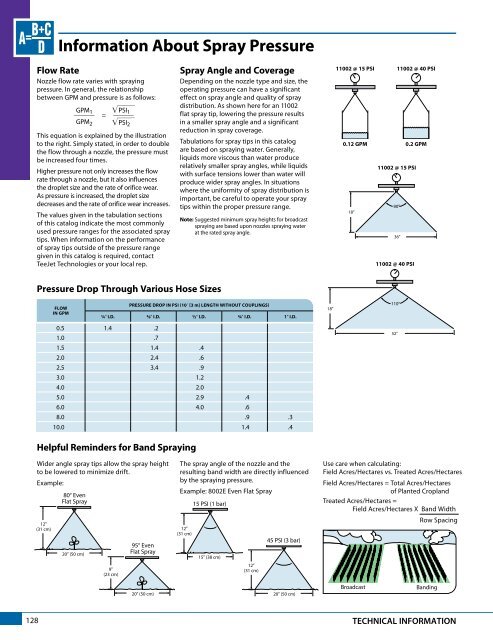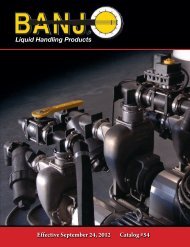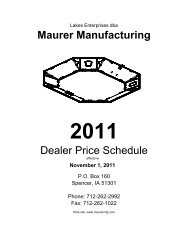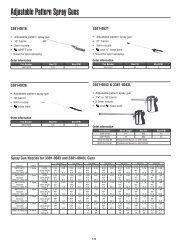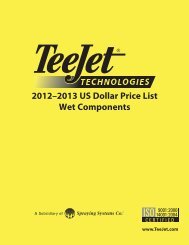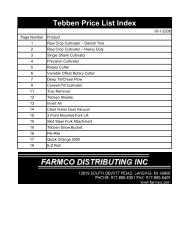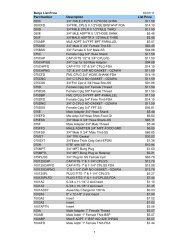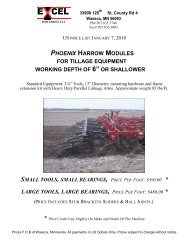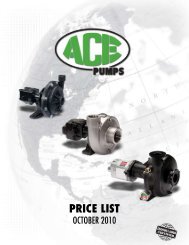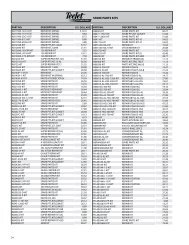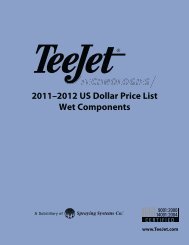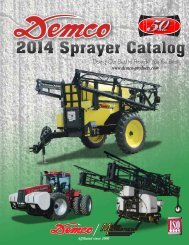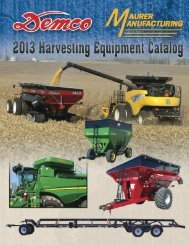Teejet Catalog 51 - Farmco Distributing Inc
Teejet Catalog 51 - Farmco Distributing Inc
Teejet Catalog 51 - Farmco Distributing Inc
Create successful ePaper yourself
Turn your PDF publications into a flip-book with our unique Google optimized e-Paper software.
Information About Spray Pressure<br />
Flow Rate<br />
Nozzle flow rate varies with spraying<br />
pressure. In general, the relationship<br />
between GPM and pressure is as follows:<br />
GPM 1 EDDF<br />
______ PSI 1<br />
= ______<br />
GPM 2 EDDF PSI2<br />
This equation is explained by the illus tration<br />
to the right. Simply stated, in order to double<br />
the flow through a nozzle, the pressure must<br />
be increased four times.<br />
Higher pressure not only increases the flow<br />
rate through a nozzle, but it also influences<br />
the droplet size and the rate of orifice wear.<br />
As pressure is increased, the droplet size<br />
decreases and the rate of orifice wear increases.<br />
The values given in the tabulation sections<br />
of this catalog indicate the most commonly<br />
used pressure ranges for the associated spray<br />
tips. When information on the performance<br />
of spray tips outside of the pressure range<br />
given in this catalog is required, contact<br />
TeeJet Technologies or your local rep.<br />
Spray Angle and Coverage<br />
Depending on the nozzle type and size, the<br />
operating pressure can have a significant<br />
effect on spray angle and quality of spray<br />
distribution. As shown here for an 11002<br />
flat spray tip, lowering the pressure results<br />
in a smaller spray angle and a significant<br />
reduction in spray coverage.<br />
Tabulations for spray tips in this catalog<br />
are based on spraying water. Generally,<br />
liquids more viscous than water produce<br />
relatively smaller spray angles, while liquids<br />
with surface tensions lower than water will<br />
produce wider spray angles. In situations<br />
where the uniformity of spray distribution is<br />
important, be careful to operate your spray<br />
tips within the proper pressure range.<br />
Note: Suggested minimum spray heights for broadcast<br />
spraying are based upon nozzles spraying water<br />
at the rated spray angle.<br />
11002 @ 15 PSI 11002 @ 40 PSI<br />
0.12 GPM<br />
0.2 GPM<br />
11002 @ 15 PSI<br />
90º<br />
189<br />
369<br />
11002 @ 40 PSI<br />
Pressure Drop Through Various Hose Sizes<br />
Flow<br />
in GPM<br />
Pressure Drop in PSI (108 [3 m] length without couplings)<br />
1/49 I.D. 3/89 I.D. 1/29 I.D. 3/49 I.D. 19 I.D.<br />
0.5 1.4 .2<br />
1.0 .7<br />
1.5 1.4 .4<br />
2.0 2.4 .6<br />
2.5 3.4 .9<br />
3.0 1.2<br />
4.0 2.0<br />
5.0 2.9 .4<br />
6.0 4.0 .6<br />
8.0 .9 .3<br />
10.0 1.4 .4<br />
189<br />
110º<br />
529<br />
Helpful Reminders for Band Spraying<br />
Wider angle spray tips allow the spray height<br />
to be lowered to minimize drift.<br />
Example:<br />
129<br />
(31 cm)<br />
80° Even<br />
Flat Spray<br />
209 (50 cm)<br />
99<br />
(23 cm)<br />
95° Even<br />
Flat Spray<br />
The spray angle of the nozzle and the<br />
resulting band width are directly influenced<br />
by the spraying pressure.<br />
Example: 8002E Even Flat Spray<br />
129<br />
(31 cm)<br />
15 PSI (1 bar)<br />
159 (38 cm)<br />
129<br />
(31 cm)<br />
45 PSI (3 bar)<br />
Use care when calculating:<br />
Field Acres/Hectares vs. Treated Acres/Hectares<br />
Field Acres/Hectares = Total Acres/Hectares<br />
of Planted Cropland<br />
Treated Acres/Hectares =<br />
Field Acres/Hectares X Band Width<br />
Row Spacing<br />
209 (50 cm)<br />
209 (50 cm)<br />
Broadcast<br />
Banding<br />
128<br />
TECHNICAL INFORMATION


